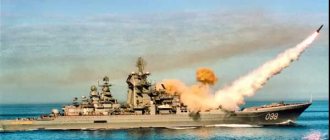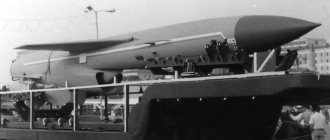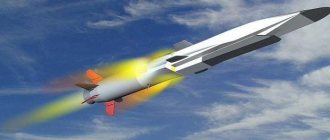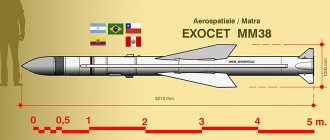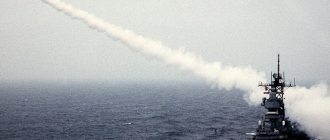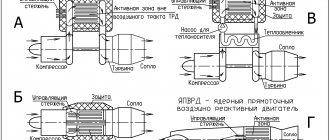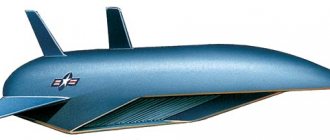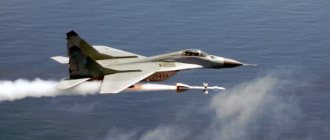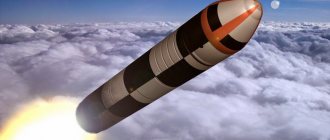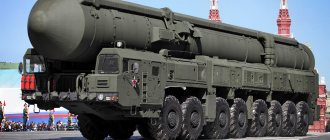From the water and from under the water: “Basalt” attacks
On February 28, 1963, development began on one of the most powerful and effective complexes of heavy anti-ship cruise missiles
Launch of the P-500 missile from the Varyag missile cruiser.
Photo from the site https://bastion-opk.ru The beginning of the 1960s was marked by the appearance of the world's first nuclear-powered aircraft carrier, the Enterprise, in the US Navy. This event confirmed the information that had long worried the Soviet Union that America was relying mainly on carrier strike groups in the development of its surface forces. These groups, taking into account new energy installations, could not only ensure a “flag demonstration” at a significant distance from their shores, but also the real dominance of the American fleet in the World Ocean.
The Soviet Navy could not provide significant competition in this area, also because it was always the “younger brother” of the Soviet Army, unlike the American Navy. And the Soviet sailors were faced with the question: what kind of weapon could threaten the American AUG enough to force them to reckon with ships flying the flag of the USSR Navy, but at the same time for not too much money? And the answer was found quite quickly: they relied on heavy anti-ship missiles, which were already in service with the Soviet fleet. But the existing heavy cruise missiles P-5 and their successors - P-35 and P-6 - were clearly not enough to become a real threat to American aircraft carriers. And then, on February 28, 1963, Resolution No. 250-89 of the Council of Ministers of the USSR was born, which became the starting point in the history of the unique system of heavy anti-ship cruise missiles P-500 "Basalt" (which is noteworthy, the same resolution determined the beginning of work on the creation of a complex of anti-ship cruise missiles cruise missiles P-120 "Malachite"). And the implementation of this resolution was entrusted to OKB-52 of the Ministry of Aviation Industry - the current Military-Industrial Corporation Scientific and Production Association of Mechanical Engineering, which in those years was headed by the legendary rocket designer Vladimir Chelomey.
Faster, further, more invisible
It is noteworthy that work on the P-500 missile and the complex based on it began when testing of the P-35 cruise missiles and its modification for P-6 submarines had not yet been completed. However, already at this moment it was clear that the new items were quite vulnerable to the rapidly developing air defense systems of aircraft carrier strike groups, and above all at the “high” stage of the trajectory. Another weak point of the “thirty-fifths” and “sixes” was the need for constant telecommunication with the carrier ship so that the operator could manually select and assign a priority target based on the transmission of target images from the missile. It was quite obvious that such a system, although it turned out to be quite successful and successful for its time, would quickly become obsolete - as soon as the conditional enemy (that is, the real American fleet) increased the power and expanded the capabilities of the ship's air defense systems. This means that we need to start developing a new system and new anti-ship missiles in advance, now, that will give Soviet ships a head start for a dozen or two years.
Diagram of the P-500 heavy anti-ship cruise missile. Photo from the site https://ot-a-do-ya.org
To cope with this task, several problems had to be solved. Firstly, significantly increase the missile’s flight speed: as you know, the faster the target moves, the more difficult it is to hit it. Second, change the flight path of the cruise missile, making the vulnerable “high” part as short as possible and the safer “low” part as long as possible. Third, rework the missile control system after firing so that it requires minimal intervention from the carrier ship. And fourthly, it was necessary to provide the missiles with their own “air defense” system, which would increase their chances of breaking through the enemy’s naval air defense barrier.
It was these problems that the creators of the P-500 and the Basalt complex had to solve. And I must admit, they coped with them very successfully. So much so that in many respects the P-500 missile, or, to call it by the index assigned to it by the Navy Missile and Artillery Directorate - 4K80, became the first. Moreover, it was the first not only in the Soviet Union, but also in the world.
Supersonic "Basalt"
Perhaps the most significant advantage that distinguished the P-500 rocket was its speed. Before it, not a single sea-based cruise missile in the world reached supersonic speed. And from the first days the “five hundred” learned to fly at a speed of two or two and a half Mach, that is, twice the speed of sound at the surface of the water - up to 2900 km/h.
But in order for the world's first supersonic sea-based anti-ship cruise missile to reach such a speed, the designers had to work hard. First of all, it was necessary to create a fundamentally new engine - the previous ones, running on “thirty-fifths” and “sixes,” could not accelerate the rocket like that. Naturally, the rocket scientists from OKB-52 could not cope with this problem on their own, and specialists from OKB-300, the current Soyuz Aircraft Engine Scientific and Technical Complex, came to their aid. It is noteworthy that for the OKB, the development of the P-500 rocket engine was actually the first serious task: the bureau itself was created at the enterprise, which had recently been formed on the basis of several aircraft factories and design bureaus, only on August 1, 1964. The new short-life turbojet engine with increased thrust and efficiency received the index KR-17-300. And it was he who turned the P-500 into a supersonic cruise missile - one that to this day is not in service with the navies of any other country.
Loading the P-500 missile into the launch container of the missile cruiser "Moscow". Photo from the site https://bastion-opk.ru
But it’s not enough to create an engine that allows the rocket to fly at such crazy speeds - you also need to make sure that it doesn’t suffer from this race! The previous materials that were used on the P-6 and P-35 were clearly not suitable: they were designed for completely different flight conditions. Strength designers and metallurgists had to get down to business. As a result, titanium alloys were widely used in the design of the new product - and also for the first time in the history of heavy anti-ship cruise missiles. Only they provided sufficient strength at very high temperatures, to which the rocket was heated from friction with the air at such a high speed.
The wings and fin of the rocket have undergone significant changes. As on all previous cruise missiles of the Chelomeyev Design Bureau, on the P-500 the wings remained folded until it took off and left the transport and launch container. But the wings themselves became noticeably different in shape. Instead of the usual swept-back ones, the “five hundred” was equipped with trapezoidal ones with a negative sweep along the leading edge. Due to this, the new wing had the area necessary for stable flight with a small span, which determined the size of the container. In addition, the new design made the wing sufficiently rigid and strong so that it, firstly, could withstand supersonic speeds, and secondly, work effectively at them. And the keel of the P-500, while maintaining the traditional trapezoidal shape and ventral location, became noticeably longer, which provided the area and strength necessary for normal stabilization and flight control without changing the dimensions of the rocket.
Wolf Pack P-500
Another unconditional superiority of the P-500 among similar sea-based cruise missiles is its unique control system and onboard electronic countermeasures station, in other words, an onboard jammer.
It’s worth starting, perhaps, with the control system, which for the first time in history used an installed on-board digital computer made on micromodules. The control system itself, which included both equipment installed on the P-500 rocket and on board the carrier ship, was called “Argon” and was one of the most advanced for its time. From its predecessors - the P-35 and P-6 cruise missiles - the "five hundred" inherited a remote control system from the carrier. But, for example, the operating mode of the missile homing head has become completely different. Since a constantly working seeker emitter not only allows the missile not to lose its target, but also allows the target to “see” that the enemy is looking for it, the homing system on the P-500 did not work all the time. As soon as the missile, traveling on a “high” part of the trajectory, captured the target at the operator’s direction, the homing head emitter was turned off, only to turn on again when approaching the target. According to the developers, a couple of minutes, during which the missile rapidly rushing to its destination was “silent”, without letting the target know about itself, was enough to deceive the ship’s air defense detection system, but not enough for the target itself to have time to move far from its place , where she was “captured” by the P-500 homing system.
A P-500 missile launches from a launch container during testing. Photo from the site https://bastion-opk.ru
But the innovations in the control system did not end there. The tactics for using the Basalt system included exclusively salvo use of P-500 cruise missiles. The idea was simple: with the improvement of shipboard air defense and missile defense systems, it is not a single missile that has a higher chance of breaking through to the target, but a missile from a whole flock launched by a carrier. But how can we make this flock not only fly in one direction, but also act together, deciding who hits what target and choosing the most important ones among them?
This opportunity was given to the Basalt complex by the Argon control system and on-board digital computers installed on the rockets. Now - for the first time in the world! - out of eight missiles fired in a salvo (that’s what the maximum salvo was), the one that went the highest - at an altitude of 5 km, in order not to lose sight of the target, became a kind of “target designator”. She maintained contact with the carrier and herself searched for targets in a passive mode, and if necessary and if conditions allowed, then in an active one. It was this leading missile that chose the largest target in the order, believing that this was an aircraft carrier (for which, in theory, this particular missile was equipped with a nuclear warhead), and then distributed the remaining targets among those moving at an altitude of 40-50 m above the surface seas with the remaining seven P-500s, helping them not to all aim at one ship together. Then the lead missile descended sharply, all eight turned on their homing heads and went towards their targets. Moreover, the enemy could not get rid of the threat by shooting down a high-flying “commander” missile: as soon as it died, another missile took over its role, and the target ship could not predict which one.
A missile with its own air defense
And the enemy could no longer rely on simply launching an anti-aircraft missile in the direction of the attacking P-500 and waiting for it to destroy the threat. On the P-500 - and again for the first time in the world! — installed an on-board electronic defense system, which ensured the removal of anti-aircraft missiles and air-to-air missiles, which were equipped with fighters based on aircraft carriers. So even after the P-500 and the Basalt system were put into service in 1975, the F-14 Tomcat fighters equipped with the most modern Phoenix missiles could not guarantee that they would not allow dangerous guests to their aircraft carriers and other carrier strike ships groups.
View of the Basalt complex launchers on the Project 1164 cruiser. Photo from the site https://ot-a-do-ya.org
By the way, it was the emergence and active development of the tactics of using carrier strike groups of the US Navy that forced the Soviet Navy to create one of the most modern information and reconnaissance systems of the USSR at that time - the Maritime Space Reconnaissance and Targeting System (MCRS). Moreover, for the first time this system was used in full precisely in conjunction with the Basalt system. So we can assume that, to some extent, the appearance of the P-500 served as one of the reasons for the development of the ICRC: it was it that provided the Basalt system with the ability to accurately and timely detect targets, distribute them into classes, track and issue operational target designation.
The history and intricacies of the work of the ICRC are written in detail here, and we will not delve into them again. It is only worth noting that the first part of the complex, the basis of which was radar reconnaissance satellites, was put into service in the same year when the P-500 missiles entered service with Soviet submarines - in 1975. And three years later, soon after the Basalt was adopted by surface ships - aircraft-carrying cruisers of the Kiev type, the ICRC became fully operational, including electronic reconnaissance satellites.
12 years from drawing board to deck
However, all this was still ahead, when in December 1963, Chelomeyev OKB-52 was finishing work on the draft model of the future P-500. And far ahead: since the developers were faced with the task of creating a rocket and a complex based on it, which had never existed, work on the new product dragged on for a long time. Only six years later, in 1969, the first ground tests began at the Nenoksa naval test site (the current 45th State Central Naval Test Site of the Navy).
First, so-called throwing tests were carried out, which started in May 1969. Then came the turn of autonomous flights, in which rockets not equipped with radio equipment were used. At this stage, the most important thing was to understand how the P-500 prototypes behave in the air in different modes, how stable they are in flight, and so on. These launches, during which six missiles took off, continued until June 1970, after which there was a short pause in the tests: full-fledged P-500s with full radio equipment were being prepared for the next stage. The launches of these missiles began in July 1971 - but, alas, they did not end very well. The control system malfunctioned, the missiles did not fly where and how the testers wanted them to fly. As a result, the launches were stopped, taking a time out to finalize the systems, and resumed almost a year later.
This stage of testing also could not be called easy. But nevertheless, the missiles gradually “learned” to carry out the tasks assigned to them, coordinate their actions with each other and attack the enemy as they were supposed to. By November 1973, this testing phase was completed; a total of 14 missiles were launched. And five months later the next, final stage of testing began. It consisted of the launch of 14 heavy anti-ship cruise missiles P-500, including salvoes of two and three missiles, in the White Sea from the K-28 submarine of Project 675. The last of them was launched on October 9, 1974, and on August 11, 1975 On the 1st, the Basalt complex and the P-500 missile were adopted by the Navy by a joint resolution of the CPSU Central Committee and the Council of Ministers of the USSR.
Submarines receive P-500
Submariners were the first to receive new cruise missiles. Since the P-500 missiles were developed in such a way that, after a slight extension, they could use transport and launch containers from P-6 missiles, nuclear submarines of Project 675 began to be converted to use the Basalt complex. After all, they were designed for the complex from the very beginning P-6 cruise missiles, which means they were easiest to adapt to the use of the new product.
Project 675MK submarine armed with P-500 cruise missiles of the Basalt complex. Photo from the site https://razgromflota.ru
In total, nine submarines were modernized under Project 675MK, which provided for the installation of eight transport and launch containers for P-500 missiles on submarines. Another boat - the same K-28 - was modernized according to Project 675MU: it was equipped with the “Success” target designation system. And these were the last Soviet submarines that were armed with surface-launched anti-ship cruise missiles. Alas, the extra time that the boats spent surfacing and preparing for the salvo and the need to remain on the surface until all eight missiles hit their targets made the Project 675MK submarines too vulnerable. And most importantly, the surface launch of cruise missiles deprived the submarines of their most important advantage - stealth, openly unmasking the position of the submarine at the moment the missiles were launched.
The fate of the P-500 on surface ships was much more successful. As mentioned at the beginning, the P-500 was the first OKB-52 cruise missile developed as a universal weapon for submarines and surface ships. But if the submarine carriers were already ready by the time the Basalt complex was put into service, the first ships for it - aircraft-carrying cruisers of the Kyiv type - were just being delivered and laid down. So the developers who were responsible for creating the surface-based version of the P-500 missile launch system for the Basalt complex had the time and opportunity to deal with one unpleasant feature of the new missiles that emerged during testing.
Launchers of the Basalt complex on the forecastle of the aircraft-carrying cruiser Baku. Photo from the site https://razgromflota.ru
The launch schedule for the P-500 missiles provided for almost half a minute of acceleration of the main engine in an open container, after which the missile was launched towards the target. During salvo firing, the main engines of all eight missiles were supposed to start accelerating simultaneously. But during the first test salvos, it turned out that powder gases from the starting engines of the first rocket entered the air intakes of the others - and jammed their main engines! This happened due to a lack of oxygen and high temperature of the gases. On submarines, it was possible to cope with this problem only after the developers of the launcher for surface ships solved it using software methods. As a result, the optimal order for launching missiles in a salvo was found, which made it possible to avoid jamming the main engines: in the sequence 4-7-3-8-1-6-2-5.
Missile-carrying cruisers
The first surface ship to receive twin P-500 launchers of the Basalt complex was the Project 1143 aircraft-carrying cruiser Kiev. It entered service in 1975, and in 1976 it moved to its place of service - the Northern Fleet. It was there that the cruiser tested its new missile system in the second half of the year, following which in 1977 the Basalt was accepted into service with surface ships. Two years after Kiev, the second cruiser of Project 1143, Minsk, entered service, and in 1982, the third, Novorossiysk. All three ships had four twin launchers of the Basalt complex, which housed eight P-500 missiles. Another eight of the same missiles were stored in the cruiser's arsenal so that, if necessary, the launchers could be reloaded after a salvo. But this process turned out to be so complicated that on the last ship of the project, the cruiser Baku (later renamed Admiral of the Fleet of the Soviet Union Gorshkov), spare missiles were abandoned, instead increasing the number of launchers to six, and containers with missiles to twelve.
Twin launchers with containers for P-500 missiles on the deck of the aircraft-carrying cruiser Kiev. Photo from the site https://testpilot.ru
When the heavy aircraft-carrying cruiser "Kyiv" was just being prepared for launch in 1972, the Northern Design Bureau in Leningrad was tasked with creating cruisers of a new project - 1164, which received the code "Atlant", and in the West called "Slava-class". The ships received this name from the first cruiser of the project, which entered service in 1983. Initially, these ships were supposed to carry the same number of Basalt launchers as the Baku - twelve, but they were supposed to be positioned differently: three pairs on each side, motionless, at an angle to the longitudinal axis of the ship. But already at the stage of work on the preliminary design, it became clear that the ship could carry more missiles, so in the end their number was increased to 16. But on these cruisers there were no problems with gas contamination of the launchers at the time of the salvo: each container received its own outboard gas outlet
The first to enter service in 1983 was the missile cruiser "Slava", which in 1996 inherited the name "Moscow" from the anti-submarine cruiser of Project 1123, which went into reserve. The next was the missile cruiser "Marshal Ustinov", which entered service in 1986, and the last, the third was the Chervona Ukraine missile cruise, renamed Varyag in 1996.
Is Basalt outdated?
At the time of its adoption, the Basalt complex was superior in efficiency and tactical and technical characteristics to all existing Soviet and developed foreign complexes of the same purpose. And to this day it, albeit in a modified version of the P-1000 Vulcan, remains in naval service. In particular, it is the “Vulcans” with the P-1000 cruise missiles, which are a slightly lighter P-500 missile with a longer range and a new control system, that are armed with the current flagship of the Black Sea Fleet, the missile cruiser “Moskva”. The same complex is carried on board the Varyag missile cruiser, the flagship of the Russian Pacific Fleet. And the missile cruiser "Marshal Ustinov", still serving in the Northern Fleet, as before, is armed with the good old "Basalt".
Missile cruiser "Marshal Ustinov", armed with the "Basalt" system with P-500 cruise missiles. Photo from the site https://vpk-news.ru
Recently, both Russian and Western missile designers are gradually abandoning the creation of heavy anti-ship cruise missiles. The bet is on creating a dense “swarm” of light anti-ship cruise missiles, each of which alone is not capable of sinking a large enough ship, but being hit by several at once will certainly be fatal for it. At the same time, a dense swarm overloads the ship’s air defense guidance systems, and due to this, the attacking “flock” has a higher chance of reaching the target. But all these considerations do not indicate that it is time to write off the reliable “Basalt” and its successors - “Vulcan” and “Granite”. According to experts, combining heavy anti-ship cruise missiles with their lighter “sisters” can be much more effective than using each type separately.
Based on materials from the sites: https://rbase.new-factoria.ru https://bastion-karpenko.ru https://testpilot.ru https://wartools.ru https://www.cruiser-moskva.info https ://razgromflota.ru https://ot-a-do-ya.org https://bastion-opk.ru https://kollektsiya.ru https://militaryrussia.ru https://tvzvezda.ru https ://www.deepstorm.ru https://ru.wikipedia.org https://vpk-news.ru
General information
Even during the times of the Soviet Union, particularly great attention was paid to the construction of coastal missile systems (CBMS), since they were an important means capable of ensuring naval superiority over Western countries. During the years of the USSR, several complexes were created whose task was to provide coastal defense. Soviet engineers designed operational-tactical systems capable of sending a missile over a distance of more than 200 thousand meters. And today similar missile systems are used in Russia, photos of which are presented in the article. Coastal missile and artillery troops, like the marine corps, are staffed by the Navy troops.
Of course, over time, Soviet-made systems become obsolete and must be replaced. According to experts, new missile systems are being developed in Russia on the basis of old ballistic missile systems. With their help, surface ships, landing troops and enemy convoys are destroyed. In addition, the complexes cover naval bases, coastal naval facilities, coastal sea communications and military groups operating in one or another coastal direction. Experts say that Russia's strategic missile systems can be used in cases where it is necessary to destroy an enemy base or port.
"Elbrus" 9K72
Russia's Elbrus operational-tactical missile systems were designed between 1958 and 1961. The destruction of a target (both a ship and enemy personnel, an airfield, a command post and other military facilities) is carried out by a single-stage liquid-propellant rocket 8K14 (R-17), which is fueled with TM-185 fuel (special rocket kerosene based on hydrocarbons) and an AK-oxidizer. 27I. The latter is made by combining nitric acid with nitrogen tetroxide. The length of the R-17 reaches 11.16 meters. The diameter of the rocket is 88 cm. It weighs up to 5862 kg, and is designed for a flight range within a radius of 50-300 thousand meters. The R-17 is produced with a non-detachable high-explosive fragmentation warhead weighing 987 kg, which is equipped with TGAG-5 (phlegmatizer with TNT-RDX aluminum mixture). Today, these operational missile systems in Russia are considered obsolete, but reliable. The SCRCs are in service with the Navy, but the production of components for them was stopped back in 1980.
"Bereg" A-222
Soviet weapons designers at OKB-2 began working on the creation of a self-propelled artillery mount in 1976. In the technical documentation, which was transferred to, the complex is written as follows: 130-mm DBK "Bereg" A-222. By 1988, a prototype was prepared. After the tests, the engineers came to the conclusion that the DBK needs to be improved. It was finally ready in 1992. At the same time, state tests took place. The anti-ship missile launched from the DBK managed to destroy a large target with an accurate hit.
The general public saw the coastal missile system only in 1993. At that time, an arms exhibition was held in Abu Dhabi, to which the Bereg DBK was delivered. After these events, the complex was tested several times. The Russian Navy has had it since 1996. Since August 2003, the Bereg DBK has been assigned to the Novorossiysk naval base BRAP 40. The targets for destruction by this self-propelled artillery system are small and medium-sized surface ships. According to military experts, the missile can reach high-speed ships reaching speeds of up to 100 nautical knots (over 180 km/h).
The area of operation of the DBK became tidal zones, island and skerry areas. In addition, the missile can quite successfully hit a ground target. The capabilities of the anti-ship missile system allow it to detect targets within a radius of up to 30 thousand meters. It poses a direct threat to enemy targets at a distance of up to 23 thousand meters. The composition of the coastal missile system can be represented by:
- 130-mm self-propelled artillery units in the amount of 4 or 6 units.
- Mobile central post with management system MR-195.
- One or two duty vehicles.
- Two 30 kW units as energy sources.
- One turret machine gun mount of 7.62 mm caliber.
- Mini-dining room for the combat crew.
All vehicles have an 8x8 wheel arrangement. Russian designers used the chassis of a cross-country vehicle (MAZ-543 M). The combat crew consists of 8 people. The power reserve is 650 km. It takes about 5 minutes to deploy.
The advantages of this coastal artillery complex are its large caliber and high rate of fire: 72 shells can be fired at the enemy within one minute. Thanks to its technical maneuverability, high automatic firing efficiency and full autonomy, the Bereg is considered an effective means of performing defense missions. According to experts, the production of weapon systems with similar performance characteristics has not yet been established throughout the world. The Russian Navy has 36 similar installations in service.
DBK "Rubezh"
The coastal missile system was designed in 1970. In service with the Army (and later the Navy) since 1978. The target is destroyed using the Termit P-15M anti-ship missile. There are also two versions of the missile with an active seeker (P-21 and P-22), which has a passive pulse radar homing head. Anti-ship missiles with autonomous target designation. The DBK uses the Harpun control center radar system, a self-propelled launcher on the MAZ-543M or 543V chassis. The target detection range is 120 km. On average, the SPU covers 50 km per hour.
PKR P-1000
According to experts, this anti-ship missile system uses the same launch equipment as the P-500. The Vulcan anti-ship missile system began to be developed in 1979. A number of improvements were made to its design, which had a positive effect on the combat range. At DBK, engineers decided to use an improved starting engine, increased the amount of fuel in the sustainer stage, and reduced the armor protection of the hull, the material for which was titanium alloys. The P-1000 is made with a short-life turbojet engine KR-17V and a new powerful launch accelerator. There is also a design possibility to deflect the thrust vector. The high-explosive fragmentation warhead weighs 500 kg. As a result of the transformations carried out, the flight range of the P-1000 was increased to 1 thousand km. The missile uses a combined flight pattern: it overcomes the sustaining phase at a high altitude, and when approaching the target, it drops to 20 meters. Since the fuel supply in the P-1000 has been increased, it can stay in a low-altitude area longer. As a result, the anti-ship missile system is less vulnerable to enemy anti-aircraft missile systems.
DBK "Utes"
In the fall of 2014, Russian engineers restored the Utes silo-based coastal missile system in Crimea. Its base was guarded facility No. 100 in the village of Reservnoye. It was created back in 1957. According to experts, anti-ship missiles fired from the complex are capable of destroying any target in the Black Sea. This explains why the USSR military command often visited the facility with regular inspections.
After the collapse of the Soviet Union, “Sotka” was subordinated to several units of the Ukrainian naval forces, but no one really dealt with the object. As a result, he completely lost money. By restoring it after the events of the Crimean Spring, Russian engineers accomplished a real technical feat. Firing from the complex is carried out by a P-35 missile with a flexible programmable flight path.
Surface ships, submarines and coastal missile systems are armed with these missile defense systems. The anti-ship missile system is capable of hitting a naval target at a distance of up to 450 km. DBK "Utes" can work as one system with the coastal complexes "Bastion" and "Ball".
DBK "Ball"
It is one of the modern missile systems in Russia. It has been in service with the Navy since 2008. The X-35 anti-ship missile is firing. Through the anti-ship missile system, the Russian military controls territorial waters and strait zones, protects naval bases, various coastal facilities and coastal infrastructure. According to experts, the Bal missile system is successfully used for security in those places that are considered convenient for enemy landings. DBK is a mobile system using the MZKT-7930 chassis. The composition of the complex is presented:
- Two self-propelled command posts that provide control and communications.
- Self-propelled launchers in the amount of 4 pcs. The SPU contains transport and launch containers (TPCs) with anti-ship missiles. For this coastal system, anti-ship missiles Kh-35 and its modifications Kh-35E and Kh-35UE are used in Russia. For one DBK there are 8 TPK. The SPU combat crew consists of 6 people.
- Transport and handling machines (TPM) in the amount of 4 pcs. Their task is to ensure a second salvo.
The advantages of the complexes are that they are effective in various meteorological conditions. Also, the functionality of the “Bal” complex is not affected by enemy fire and electronic countermeasures. For the DBK, complexes are provided that cause passive interference, which has a positive effect on the invulnerability of the RPK. To deploy the launcher, the combat crew will need about 10 minutes.
DBK "Uran" X-35
Created in 1995 by employees of the State Scientific Production Plant. The complex is represented by the X-35 cruise missile, transport and launch containers (TPC), launchers, a ship-based automated control system and a complex with ground equipment. Storage, transportation and combat use of the X-35 is carried out using a TPK. The container is a cylinder with special guides inside. The end parts of the TPK are closed. The covers are folded back by spring mechanisms when the pyrobolts are activated. With the help of the Uran anti-ship missile system, enemy surface ships with a displacement of no more than 5 thousand tons are destroyed. The X-35 Uran missile is small-sized and versatile. It is widely used by the Russian Navy.
The advantage of the Uran anti-ship missile system is that, due to its small dimensions and weight, it can be transported by any ship or aircraft. For example, in aviation, the Kh-35 missile is used by the Su-30SM and Su-35S multi-role fighters, the Su-34 Duckling and Su-24 front-line bombers, the Mig-29 SMT multi-role light fighters and the Ka-27, 28, 52K helicopters. In the navy, the anti-ship coastal missile system is used by frigates, corvettes (project 22380), the Yaroslav the Mudry patrol ship (project 11540), missile boats, nuclear submarines Yasen and Yasen-M of projects No. 885 and 885M.
The X-35 has a two-stage design, equipped with a launch accelerator and a sustainer engine. The maximum range is 260 thousand meters. The target is hit by a penetrating high-explosive fragmentation warhead, which weighs 145 kg. The X-35 was equipped with an active radar homing head (ARLGSN), thanks to which the missile can search for a target in autonomous mode. The Kh-35 is used by the Russian Bal coastal missile systems.
"Bastion" K-300
Design work on the creation of this complex began in the late 80s of the last century. The soldiers of the Soviet army were not satisfied with the Redut and Rubezh anti-ship missile systems available at that time. The reason was that these complexes were released in 1960 and were considered quite outdated. "Bastion" was ready in 1985. Two years later, the first testing of the DBK took place. Then the surface ship became its base. In 1992, a missile from this complex was launched from a submarine for the first time. The final testing of these anti-ship missiles in Russia was completed in 2002.
The work was delayed not due to the fault of the engineers, but due to the difficult economic situation in the country. They have been in service with the Russian Navy since 2010. The production of anti-ship missiles in Russia for the K-300 is carried out by the Orenburg NPO Strela. The coastal anti-ship missile system is equipped with an 8.2-meter Onyx missile weighing 3 tons. This anti-ship missile system is equipped with an air-breathing ramjet engine, for which a solid propellant initial accelerator is provided. Thanks to it, Onyx can fly 750 m in a second. The power unit is refueled with kerosene.
“Onyx” can get to the area where its target is located using an inertial navigation system. Preliminary target acquisition is carried out by turning on the homing head. Now the anti-ship missile can fly at extremely low altitudes (from 10 to 15 meters). This explains why these Russian anti-ship missiles are invulnerable to enemy air defenses at the final stage of flight. The operational life of the RCC does not exceed 10 years. The target is destroyed by a penetrating warhead weighing 300 kg. "Bastion" K-300 is equipped with:
- Self-propelled launchers.
- Missiles in TPK.
- By KamAZ-43101 vehicle. Combat control is performed by 4 people.
- Equipment that provides information and technical communication between the SCRC and the command post.
- Maintenance means.
